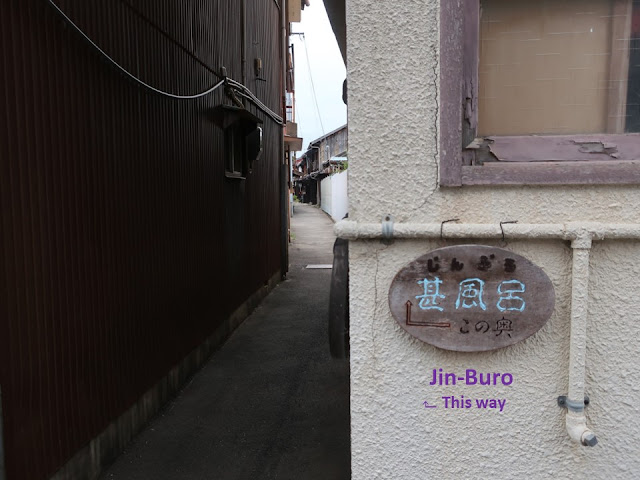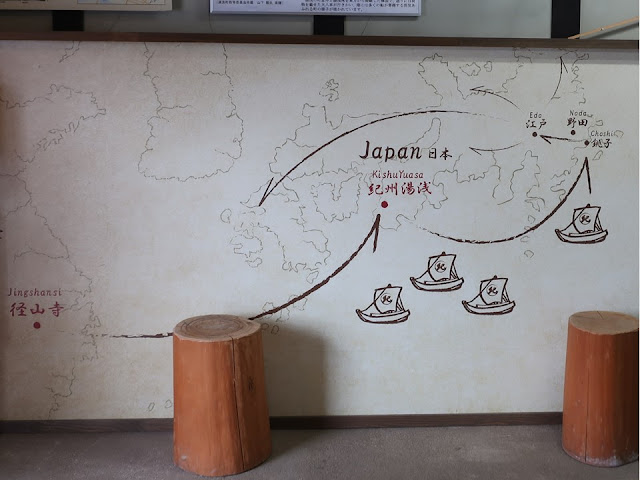Yuasa is the birthplace of soy sauce brewing. It is in Wakayama prefecture of western Japan. It is also designated as “Preservation Districts for Groups of Traditional Buildings” by the government. Jin-Buro was the public bathhouse in the town; it was established in the Edo period (1603~1868) and was operated until 1985. The building is open to the public as Jin-Buro (bathhouse) Museum.
和歌山県中部、海に面した湯浅町は、醤油発祥の町。重要伝統的建造物群保存地区に指定されています。その中に江戸時代に創業し、昭和60年まで営業していた銭湯、甚風呂さんが、銭湯跡歴史資料館として公開されています。
There are old building along narrow roads.
狭い道に沿って古風な建物が並びます。
There is a signboard of “Jin-Buro” at the corner of the alley.
路地の入口に、甚風呂さんの看板がありました。
Jin-Buro、甚風呂
Local pupils who joined the educational trip were at the entrance of Jin-Buro.
甚風呂さんの入口。地元の小学生たちが見学に来ていました。
The entrance and the reception counter. It says, “It (Jin-Buro) was popular among many of Yuasa’s residents, including fishermen, soy sauce shop employees, and women who supported their households.” The staff who explained to the pupils said, “There were no TVs before, so a public bathhouse was an important place to get information.” It is also important to communicate in person, I think.
甚風呂は「漁民や醤油屋の使用人、家庭を支える女性など湯浅の様々な人々にしたしまれていました」と書かれています。小学生に説明していた職員さんは、「昔はTVが無かったので、銭湯は情報を得るための大切な場所だったのよ」と言っていました。F to Fのコミュニティも大切ですね。
I went through the bathroom for men, and went the back, then,
男湯を通って奥へ進むと、
There is an exhibition room of Yuasa Festival.
湯浅の祭りの展示室があります。
The horse run through the alley. How exciting it was!
狭い道を馬が駆け抜けます。迫力満点!
Furniture and so on are exhibited at the room faced to the courtyard.
中庭が見える住居部分は民具が展示されています。
On the second floor, utensils, signboards and so on are exhibited. The beams and walls are impressive for me; they might had withstood the great earthquake in 1946 (M8.0, 269 people were killed).
二階のショーケースにも民具や懐かしい看板が展示されていますが、梁と壁が印象的です。明治初期に建てられたということですから、1946 年の昭和南海地震(M8.0、死者 269 人)にも耐えたようです。
I downed to the first floor, went through the boiler area above,
一階に戻り、焚き場を見て、
I also went through the bathroom for women and the changing room for them, and reached to the entrance. You can imagine the voices of chatting women here.
女湯から玄関に戻ります。おしゃべりしている声が聞こえてきそう。
Walking about Yuasa town、街歩き
The panel in the rest area of “Okamasa” tells us the origin of soy source which is the crucial seasoning for Japanese cuisine.
The monk, who went to Sung (China) for training in the 13th century, brought special miso to Japan. He taught Yuasa people how to make it. They found the drip of the miso made a simmered food delicious by chance.
Yuasa’s soy sauce is dark-colored one, which became popular among people in Edo (Tokyo). Some of brewers moved to the Edo region and made it.
湯浅で始まった醤油製造(岡正(休憩所)のパネル):禅僧(覚心)が鎌倉時代に宋から持ち帰った味噌を元に金山寺味噌を作っていたところ、桶の底に溜まった液で煮物を作ると美味しいことを発見。醤油の原型を作り上げました。湯浅の醤油は濃口で、江戸で好まれ、関東で醤油醸造をする者も現れました。
Former Suhara family residence、旧栖原家住宅
The factory and residence of the brewer which was built in 1874 was renovated and is opened to the public. Soy source was made until 1982 here. Yuasa town makes effort to preserve their town and to make it a tourist attraction.
明治7年に建てられた醤油醸造家の工場兼住居がリニューアルされ、公開されています。1982年まで、醤油を作っていました。湯浅町は町の保存に、観光地化に力を入れていますね。
The tatami mat rooms are great, however the rooms for young workers are shabby. Lads upped to the second floor through the staircase on the right. Lass's room is on the left side.
座敷が立派に改修されていますが、右端の急階段に注目です。若衆部屋の入口です。写真の左側には女中部屋への階段があります。窮屈そうですね。
There is a house which is not renovated yet. There is a nostalgic corner which has an old-type post and signboards (lower left).
まだ改修していない家(右)、レトロな街角(左下)も残っています。
The stone monument is a signpost which shows us the ways to Kumano (shrines), Kimiidera (temple) and Kouyasan (temple); it was built in 1838. Yuasa was developed in the Muromachi period (1338-1573) as a post-town to those pilgrimage destinations.
Reference articles: Kumano Nachi Taisha (shrine)、熊野那智大社 、 Kouyasan Kongoubuji 高野山金剛峯寺
室町時代には熊野街道の宿駅として発展しました。1838年に建てられた道標が街角に残っています。熊野、紀三井寺、高野山・伊勢への道を示しています。
The soy source brewer along the river (black buildings, “Kadocho”) was established in 1841. The company in the three-story building in behind operates leisure fishing boats. The sea is near. It’s a charming town, however, the tsunami hit them in 1854.
川沿いには1841年創業の醤油屋・角長さん。その先に、釣り船・磯渡しのなぎ丸さん。海は目の前、味のある街ですが、安政南海地震では大津波の被害にもあいました。
Official
website: http://www.denken-yuasa.sakura.ne.jp/jinburo/
(in Japanese), accessed in November, 2023
Visited in
March, 2023
Previous post (Japanese plum museum in the same prefecture): MINABE
Town UME Promotion Museum、みなべ町うめ振興館
Next post (museum in the neighboring city):Arida city museum、有田市郷土資料館

















Comments
Post a Comment